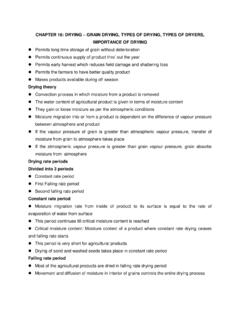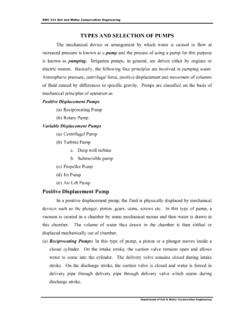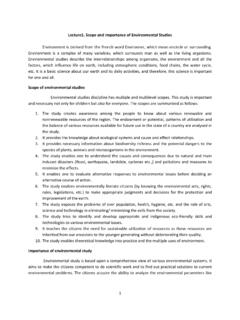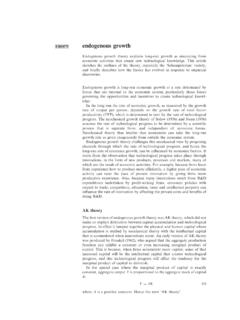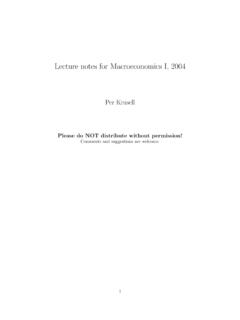Transcription of PLANT GROWTH REGULATORS - eagri.org
1 20. PLANT GROWTH REGULATORS . PLANT GROWTH REGULATORS or phytohormones are organic substances produced naturally in higher plants, controlling GROWTH or other physiological functions at a site remote from its place of production and active in minute amounts. Thimmann (1948) proposed the term Phyto hormone as these hormones are synthesized in plants. PLANT GROWTH REGULATORS include auxins, gibberellins, cytokinins, ethylene, GROWTH retardants and GROWTH inhibitors. Auxins are the hormones first discovered in plants and later gibberellins and cytokinins were also discovered. Hormone An endogenous compound, which is synthesized at one site and transported to another site where it exerts a physiological effect in very low concentration. But ethylene (gaseous nature), exert a physiological effect only at a near a site where it is synthesized.
2 Classified definition of a hormone does not apply to ethylene. PLANT GROWTH REGULATORS Defined as organic compounds other than nutrients, that affects the physiological processes of GROWTH and development in plants when applied in low concentrations. Defined as either natural or synthetic compounds that are applied directly to a target PLANT to alter its life processes or its structure to improve quality, increase yields, or facilitate harvesting. PLANT Hormone When correctly used, is restricted to naturally occurring PLANT substances, there fall into five classes. Auxin, Gibberellins, Cytokinin, ABA and ethylene. PLANT GROWTH regulator includes synthetic compounds as well as naturally occurring hormones. PLANT GROWTH Hormone The primary site of action of PLANT GROWTH hormones at the molecular level remains unresolved.
3 Reasons Each hormone produces a great variety of physiological responses. Several of these responses to different hormones frequently are similar. The response of a PLANT or a PLANT part to PLANT GROWTH REGULATORS may vary with the variety of the PLANT . Even a single variety may respond differently depending on its age, environmental conditions and physiological state of development (especially its natural hormone content) and state of nutrition. There are always exceptions for a general rule suggesting the action of a specific GROWTH regulator on plants. There are several proposed modes of action in each class of PLANT hormone, with substantial arguments for and against each mode. Hormone groups Auxin - Substances generally resembles IAA and has the ability to stimulate the elongation of coleoptiles.
4 Gibberellins - are diterpenoids, which have the ability to elongate the stem of green seedlings especially certain dwarf and rosette types. Cytokinin - Usually substituted Adenines, which resembles zeatin (Naturally occurring cytokinin in Zea mays) and have the ability to stimulate cytokinensis in cultures of tobacco cells. Ethylene - Gaseous regulator that stimulate is diametric GROWTH in the apices of dicot seedlings. Inhibitors - are REGULATORS of GROWTH , which originally depress the Auxins Auxins are a group of phytohormones produced in the shoot and root apices and they migrate from the apex to the zone of elongation. Auxins promote the GROWTH along the longitudinal axis of the PLANT and hence the name (auxeing : to grow). The term, auxin was introduced by Kogl and Haagen- Smit (1931). Went (1928) isolated auxin from the Avena coleoptile tips by a method called Avena coleoptile or curvature test and concluded that no GROWTH can occur without auxin.
5 Auxins are widely distributed through out the PLANT however, abundant in the growing tips such as coleoptile tip, buds, root tips and leaves. Indole Acetic Acid (IAA) is the only naturally occurring auxin in plants. The synthetic auxins include, Avena Curvature Test IBA : Indole Butyric Acid NAA : Naphthalene Acetic acid MENA: Methyl ester of Naphthalene acetic acid MCPA: 2 Methyl 4 chloro phenoxy acetic acid TIBA : 2, 3, 5 Tri iodo benzoic acid 2, 4-D : 2, 4 dichloro phenoxy acetic acid 2, 4, 5-T: 2, 4, 5 Trichloro phenoxy acetic acid Natural auxins may occur in the form of either free auxins- which freely move or diffuse out of the PLANT tissues readily or bound auxins- which are released from PLANT tissues only after hydrolysis, autolysis or enzymolysis. Physiological effects of auxin 1. Cell division and elongation The primary physiological effects of auxin are cell division and cell elongation in the shoots.
6 It is important in the secondary GROWTH of stem and differentiation of xylem and phloem tissues. 2. Apical dominance In many plants, if the terminal bud is intact and growing, the GROWTH of lateral buds just below it remains suppressed. Removal of the apical bud results in the rapid GROWTH of lateral buds. This phenomenon in which the apical bud dominates over the lateral buds and does not allow the lateral buds to grow is known as apical dominance. Skoog and Thimmann (1948) pointed out that the apical dominance might be under the control of auxin produced at the terminal bud and which is transported downward through the stem to the lateral buds and hinders the GROWTH . They removed the apical bud and replaced it with agar block. This resulted in rapid GROWTH of lateral buds. But when they replaced the apical bud with agar block containing auxin, the lateral buds remained suppressed and did not grow.
7 3. Root initiation In contrast to stem, the higher concentration of auxin inhibits the elongation of roots but the number of lateral roots is considerably increased , higher concentration of auxin induces more lateral branch roots. Application of IAA in lanolin paste (lanolin is a soft fat prepared from wool and is good solvent for auxin) to the cut end of a young stem results in an early and extensive rooting. This fact is of great practical importance and has been widely utilized to promote root formation in economically useful plants which are propagated by cuttings. 4. Prevention of abscission Natural auxins prevent the formation of abscission layer which may otherwise result in the fall of leaves, flowers and fruits. 5. Parthenocarpy Auxin can induce the formation of parthenocarpic fruits (fruit formation without pollination and fertilization).
8 In parthenocarpic fruits, the concentration of auxin in the ovaries is higher than in the ovaries of plants which produce fruits only after fertilization. In the later cases, the concentration of the auxin in ovaries increases after pollination and fertilization. 6. Respiration Auxin stimulates respiration and there is a correlation between auxin induced GROWTH and respiration. Auxin may increase the rate of respiration indirectly through increased supply of ADP by rapidly utilizing ATP in the expanding cells. 7. Callus formation Besides cell elongation, auxin may also be active in cell division. In many tissue cultures, where the callus GROWTH is quite normal, the continued GROWTH of such callus takes place only after the addition of auxin. 8. Eradication of weeds Some synthetic auxins especially 2, 4- D and 2, 4, 5-T are useful in eradication of weeds at higher concentrations.
9 9. Flowering and sex expression Auxins generally inhibit flowering but in pine apple and lettuce it promotes uniform flowering. Distribution of auxin in plants In plants, auxin (IAA) is synthesized in growing tips or meristematic regions from where; it is transported to other PLANT parts. Hence, the highest concentration of IAA is found in growing shoot tips, young leaves and developing auxiliary shoots. In monocot seedling, the highest concentration of auxin is found in coleoptile tip which decreases progressively towards its base. In dicot seedlings, the highest concentration is found in growing regions of shoot, young leaves and developing auxiliary shoots. Within the plants, auxin may present in two forms. , free auxins and bound auxins. Free auxins are those which are easily extracted by various organic solvents such as diethyl ether.
10 Bound auxins on the other hand, need more drastic methods such as hydrolysis, autolysis, enzymolysis etc. for extraction of auxin. Bound auxins occur in plants as complexes with carbohydrates such as glucose, arabionse or sugar alcohols or proteins or amino acids such as aspartate, glutamate or with inositol. Biosynthesis of auxin (IAA) in plants Thimann (1935) found that an amino acid, tryptophan is converted into Indole 3. acetic acid. Tryptophan is the primary precursor of IAA in plants. IAA can be formed from tryptophan by two different pathways. 1. By deamination of tryptophan to form indole-3-pyruvic acid followed by decarboxylation to from indole-3-acetaldehyde. The enzymes involved are tryptophan deamintion and indole pyruvate decarboxylase respectively. 2. By decarboxylation of tryptophan to form tryptamine followed by deamination to form indole-3-acetaldehyde and the enzymes involved are tryptophan decarboxylase and tryptamine oxidase respectively.




